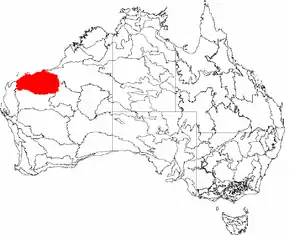Pilbara Craton
The Pilbara Craton is an old and stable part of the continental lithosphere located in Pilbara, Western Australia.

The Pilbara Craton is one of only two pristine Archaean 3.6–2.7 Ga (billion years ago) crusts identified on the Earth, along with the Kaapvaal Craton in South Africa. Both locations may have once been part of the Vaalbara Supercontinent or the continent of Ur.
In May 2017, evidence of the earliest known life on land may have been found in 3.48-billion-year-old geyserite and other related mineral deposits (often found around hot springs and geysers) uncovered in the Dresser Formation in Pilbara Craton.[1][2][3][4]
The earliest direct evidence of life on Earth may be fossils of microorganisms permineralized in 3.465-billion-year-old Australian Apex chert rocks.[5][6]
See also
References
- Staff (9 May 2017). "Oldest evidence of life on land found in 3.48-billion-year-old Australian rocks". Phys.org. Retrieved 13 May 2017.
- Djokic, Tara; Van Kranendonk, Martin J.; Campbell, Kathleen A.; Walter, Malcolm R.; Ward, Colin R. (9 May 2017). "Earliest signs of life on land preserved in ca. 3.5 Ga hot spring deposits". Nature Communications. 8: 15263. doi:10.1038/ncomms15263. PMC 5436104. PMID 28486437.
- "Dresser Formation - Pilbara". pilbara.mq.edu.au.
- Noffke, N; Christian, D; Wacey, D; Hazen, RM (December 2013). "Microbially induced sedimentary structures recording an ancient ecosystem in the ca. 3.48 billion-year-old Dresser Formation, Pilbara, Western Australia". Astrobiology. 13 (12): 1103–24. doi:10.1089/ast.2013.1030. PMC 3870916. PMID 24205812.
- Tyrell, Kelly April (18 December 2017). "Oldest fossils ever found show life on Earth began before 3.5 billion years ago". University of Wisconsin-Madison. Retrieved 27 December 2017.
- Schopf, J. William; Kitajima, Kouki; Spicuzza, Michael J.; Kudryavtsev, Anatolly B.; Valley, John W. (2017). "SIMS analyses of the oldest known assemblage of microfossils document their taxon-correlated carbon isotope compositions". PNAS. 115 (1): 53–58. doi:10.1073/pnas.1718063115. PMC 5776830. PMID 29255053.
Bibliography
- Kato, Y.; Nakamura, K. (2003). "Origin and global tectonic significance of Early Archean cherts from the Marble Bar greenstone belt, Pilbara Craton, Western Australia". Precambrian Research. 125 (3–4): 191–243. doi:10.1016/S0301-9268(03)00043-3.
- Oliver, N. H. S.; Cawood, P.A (2001). "Early tectonic dewatering and brecciation on the overturned sequence at Marble Bar, Pilbara Craton, Western Australia: dome-related or not?". Precambrian Research. 105 (1): 1–15. doi:10.1016/S0301-9268(00)00098-X.
- Terabayashi, M.; Masada, Y.; Ozawa, H. (2003). "Archean ocean-floor metamorphism in the North Pole area, Pilbara Craton, Western Australia". Precambrian Research. 127 (1–3): 167–180. doi:10.1016/S0301-9268(03)00186-4.
- Zegers, E.; de Wit, M. J.; Dann, J.; White, S. H. (1998). "Vaalbara, Earth's oldest assembled continent? A combined structural, geochronological, and palaeomagnetic test". Terra Nova. 10 (5): 250–259. CiteSeerX 10.1.1.566.6728. doi:10.1046/j.1365-3121.1998.00199.x.
External links
| Wikimedia Commons has media related to Pilbara Craton. |